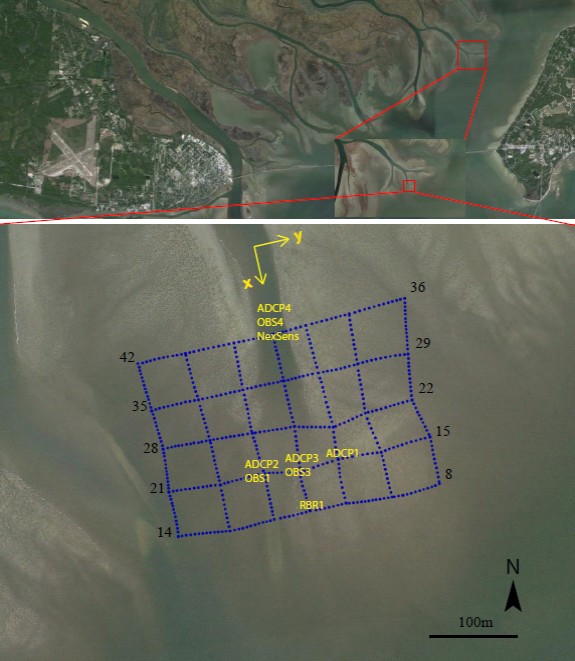58th Annual Report on Research 2013 Under Sponsorship of the ACS Petroleum Research Fund
Reports: ND851128-ND8: Evolution of Mouth Bars and Salt Marshes in Deltas: Implications for Sedimentary Deposits and Stratigraphy
Sergio Fagherazzi, Boston University
1. Tidal rythmites in river mouth bars
Mouth bars are important morphological units of deltas, estuaries and rivers and highly productive oil and gas reservoirs. They often display alternate layers of mud and sand (rythmites) that can ultimately determine their vertical permeability. We have developed an analytical, process based model to explain tidal bedding characteristics and quantify their extent in river mouth bars. Findings from our model are compared with results from the numerical model Delft3D. We propose that tidal bedding occurs in areas where alternative deposition and erosion occur, for at least one of the two fractions (Figure 1).
We further propose a facies model such that a sand deposit forms near the river mouth followed in order by a lamination zone, a homogeneous sand-mud mixture area, and mud deposits. Lamination and sand mud-mixtures form at intermediate distances from the river mouth, while mud deposits are created in the distal parts of the domain. The lamination area increases with increasing tidal amplitude. Tidal bedding properties are defined by means of bedding extension along the centerline and differences in mud content between successive layers. Both quantities have been found to increase with tidal amplitude. Lamination extension grows with decreasing ratios of mud over sand concentration and settling velocity, while the difference in mud content in successive layers has been found to increase with increasing settling velocity and concentration. Differences in mud content between different layers tend to increase far from the river mouth. The lamination area also tends to shift basinward during mouth bar evolution. Finally, bottom friction has been found to be one of the main drivers for lamination. According to our dimensional analysis, an increase in the dimensionless friction parameter reduces lamination length and increases the difference in mud content between successive layers, by means of flow deceleration and early sediment deposition.
Figure 1. Facies model for river mouth bars. On the longitudinal axis, ht/h0is the dimensionless tidal amplitude. On the vertical axis, ξ is the dimensionless longitudinal coordinate.
2. Measurements of water and sediment discharge in a delta distributary in Apalachicola, Florida
The lower Apalachicola River is located in the Florida panhandle at the terminus of the Apalachicola-Chattahoochee-Flint (ACF) River system. Deltaic processes of the Apalachicola River led to the formation of the bay which extends onto the Gulf of Mexico continental shelf. The bay encompasses about 620 km2of open water with an average depth of 1.9 m at mean low tide. Approximately 80% of the open water zone is composed of soft muddy unvegetated sediments and the remainder is divided between oyster reefs and submerged aquatic vegetation. The bay accounts for 90% of Florida’s oysters, and had the third highest catch of shrimp statewide (Chanton, 2002; Huang, 2002).
For our field measurements we chose a distributary channel that is developing a mouth bar (Figure 2). Within the channel we deployed a Nortek Acoustic Doppler Current Meter (ADCP) and measured tidal elevation and water velocity at 2Hz, recording every 30 minutes, averaging over 60 seconds and with vertical cell sizes of 10 cm. The measurements were carried out from January 22 to March 12 2013, during a ten years flooding event. Water depth was calculated by means of the ADCP piezometers and the pressure was corrected from atmospheric fluctuations using data from the NOAA station at Apalachicola (station ID 8728711). Considering the shallow depth of the channel we did not detect significant velocity variations along the vertical and velocities measurements presented herein have been averaged along the depth. Horizontal velocities have been rotated to align them with the channel axis. The amplitude of the ADCP acoustic signal has been used as a proxy for suspended sediment concentration (SSC).
Figure 2 Location of the field measurements within the Apalachicola Delta, Florida
3. Impact on the career of the PI and the graduate students
This PRF grant allowed the PI to start a new research direction on the morphological evolution and stratigraphy of deltas. Thanks to the support from this grant the PI is now actively involved in several projects in deltaic systems, including the Apalachicola Delta in Florida, the Yangtze River in China, and the Mekong delta in Vietnam. We already published three manuscripts with the numerical simulations performed in the first two years and one is currently under review. A tighter collaboration with ongoing research projects at major oil companies (Exxon-Mobil and Chevron) was possible because of this grant. A PhD and a MS dissertations originated from the results and the research. The two students are currently advancing in their career. The MS student is seeking a PhD degree under my supervision on the same topic. The graduated PhD student has received a postdoctoral appointment centered on similar research topics.
Copyright © 2014 American Chemical Society













